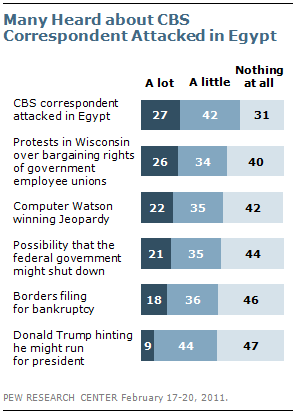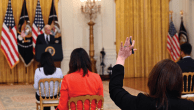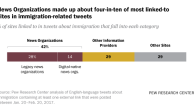Summary of Findings

The public’s interest in developments in Egypt remained high last week as the media focused increasingly on domestic debates over how to deal with the fiscal troubles facing many states and how to bring down the federal deficit.
About a third of the public (32%) says they followed news about the situation in Egypt more closely than any other news story last week. That is down from 48% one week earlier, but still ranks – by a wide margin – as the public’s top story for the week, according to the latest News Interest Index survey conducted Feb. 17-20 among 1,001 adults. And, as unrest grew in nations like Libya and Bahrain, another 3% say they followed news about anti-government protests elsewhere in the region most closely.
But the public also kept a close watch on several economic story lines. Fully 14% say news about the economy was their top story of the week. Another 14% say they most closely followed news about state and local budget problems and 8% say they followed discussions in Washington about how to address the federal budget deficit this closely.
Together, the economic themes topped coverage last week, making up a total of 35% of the newshole examined by the Pew Research Center’s Project for Excellence in Journalism (PEJ). Coverage of state budget problems, most notably the noisy confrontations in Wisconsin over the governor’s push to curtail collective bargaining rights for public employees, accounted for 16%, while the debate in Washington over the federal budget accounted for 14%. More general news about the economy totaled 5% of coverage.
Meanwhile, coverage of unrest in the Middle East and northern Africa (including Egypt) fell to 26% of the newshole; 9% focused on Egypt and 17% dealt with protests in other nations, including Iran. One week before that, unrest in the region accounted for 40% of coverage, with most focused on Egypt. The week of Jan. 31-Feb. 6, coverage of the crisis in the Middle East made up 56% of the newshole, the highest level for an international story since PEJ started its weekly analysis four years ago.
Most Aware of Lara Logan Attack, Wisconsin Protests

Slightly more than a quarter (27%) say they heard a lot last week about CBS correspondent Lara Logan being attacked while covering events in Egypt. Another 42% say they heard a little about this, while 31% say they heard nothing at all. Women were more likely than men to say they heard a lot about this story (31% vs. 22%).
About as many (26%) say they heard a lot about protests in Wisconsin over bargaining rights for government employee unions. A third (34%) say they heard a little about this, while 40% say they heard nothing at all.
Just more than two-in-ten (22%) say they heard a lot about the computer named Watson that beat two human challengers on the game show Jeopardy; 35% say they heard a little and 42% say they heard nothing at all.
Comparable numbers say they had heard about the possibility that the federal government could shut down this year if Congress and President Obama cannot agree on a budget. About two-in-ten (21%) say they heard a lot about this, 35% say they heard a little and 44% say they heard nothing at all. Roughly equal numbers of Republicans, (23%), Democrats (19%) and independents (25%) say they heard a lot about this story.
Nearly two-in-ten (18%) say they heard a lot about the bookstore chain Borders filing for bankruptcy protections, 36% say they heard a little about this and 46% say they heard nothing at all.
Just 9% say they heard a lot about businessman Donald Trump hinting that he might run for president in the 2012 elections; 44% say they heard a little about this, while 47% had heard nothing at all. Republicans were more likely to have heard a lot about this story (15%) than either Democrats (6%) or independents (7%).
The Week’s News
Americans maintain a steady interest in news about the still-struggling economy. More than a third (35%) say they followed news about the economy very closely last week, a number little changed since mid-December. About a quarter say they followed news about state and local budget problems (28%) or the federal budget deficit (27%) that closely.
In early December, immediately after the president’s deficit commission released its recommendations, 35% said they were following news about the federal deficit very closely. At that point, partisans showed comparable levels of interest (36% for Democrats, 36% for Republicans and 34% for independents). In the current survey, there is little change among Republicans or independents (32% each), while the number of Democrats following this news very closely has dropped to 23%.
About a third of the public (34%) says they followed news about the situation in Egypt very closely; about four-in-ten (39%) said this one week earlier. Another 20% say they followed news about anti-government protests in other Middle Eastern and North African nations very closely last week.

Just 6% say they very closely followed news about Italian Prime Minister Silvio Berlusconi facing charges for allegedly paying for sex with a 17-year-old girl; 1% say this was the story they followed most closely. News about Berlusconi’s legal troubles made up 1% of coverage.
These findings are based on the most recent installment of the weekly News Interest Index, an ongoing project of the Pew Research Center for the People & the Press. The index, building on the Center’s longstanding research into public attentiveness to major news stories, examines news interest as it relates to the news media’s coverage. The weekly survey is conducted in conjunction with The Project for Excellence in Journalism’s News Coverage Index, which monitors the news reported by major newspaper, television, radio and online news outlets on an ongoing basis. In the most recent week, data relating to news coverage were collected February 14-20, and survey data measuring public interest in the top news stories of the week were collected February 17-20, from a nationally representative sample of 1,001 adults.
About the Survey
The analysis in this report is based on telephone interviews conducted February 17-20, 2011 among a national sample of 1,001 adults 18 years of age or older living in the continental United States (670 respondents were interviewed on a landline telephone, and 331 were interviewed on a cell phone, including 137 who had no landline telephone). The survey was conducted by interviewers at Princeton Data Source under the direction of Princeton Survey Research Associates International. A combination of landline and cell phone random digit dial samples were used; both samples were provided by Survey Sampling International. Interviews were conducted in English. Respondents in the landline sample were selected by randomly asking for the youngest adult male or female who is now at home. Interviews in the cell sample were conducted with the person who answered the phone, if that person was an adult 18 years of age or older. For detailed information about our survey methodology, see: https://www.pewresearch.org/politics/methodology/detailed.
The combined landline and cell phone sample are weighted using an iterative technique that matches gender, age, education, race, Hispanic origin, region, and population density to parameters from the March 2010 Census Bureau’s Current Population Survey. The sample also is weighted to match current patterns of telephone status and relative usage of landline and cell phones (for those with both), based on extrapolations from the 2010 National Health Interview Survey. The weighting procedure also accounts for the fact that respondents with both landline and cell phones have a greater probability of being included in the combined sample and adjusts for household size within the landline sample. Sampling errors and statistical tests of significance take into account the effect of weighting. The following table shows the sample sizes and the error attributable to sampling that would be expected at the 95% level of confidence for different groups in the survey:

Sample sizes and sampling errors for other subgroups are available upon request.
In addition to sampling error, one should bear in mind that question wording and practical difficulties in conducting surveys can introduce error or bias into the findings of opinion polls.




